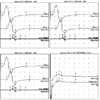Abstract
Anti-neutrophilic cytoplasmic antibody (ANCA)-associated vasculitis is a primary systemic vasculitis that affects the small vessels, and ANCA is involved as the common pathogenesis. Environmental factors such as infectious agents have been considered to play a role in triggering the autoimmunity. We report here on a case of ANCA-associated vasculitis that developed after scrub typhus. A 64-year-old male was admitted because of fever, chills, pain, weakness and hypoesthesia of his calves. He was diagnosed as having scrub typhus based on the findings of an eschar and the positive serum anti-orientia antibody. The fever continued despite the antibiotic treatment. Neurologic symptoms such as numbness, hypoesthesia and weakness began to develop in the hands, feet and calves with a persisting fever. The nerve conduction velocity study revealed mononeuritis multiplex of the superficial peroneal nerve and the median nerve. Microscopic hematuria then additionally developed, and the serology showed a positive myeloperoxidase (MPO) test. A nerve biopsy was conducted on the left superficial peroneal nerve and the result showed non-infectious systemic vasculitis of the medium-small arteries. He was diagnosed as having microscopic polyangiitis along with ANCA associated vasculitis. The fever resolved and the neurologic symptoms began to improve after steroid pulse treatment (methylprednisolone 1 g/day). The neuropathy gradually improved after discharge. We presume that the ANCA-associated vasculitis was triggered by scrub typhus.
Figures and Tables
References
1. Seong SY, Choi MS, Kim IS. Orientia tsutsugamushi infection: overview and immune responses. Microbes Infect. 2001. 3:11–21.
2. Ozaki S. ANCA-associated vasculitis: diagnostic and therapeutic strategy. Allergol Int. 2007. 56:87–96.
3. Seo P, Stone JH. The antineutrophil cytoplasmic antibody-associated vasculitides. Am J Med. 2004. 117:39–50.

4. Gorson KC. Vasculitic neuropathies: an update. Neurologist. 2007. 13:12–19.
5. Jung SJ, Cheon SH, Lee CH, Park YB, Lee SK. A case of dermatomyositis associated with scrub typhus. Korean J Med. 2007. 73:Suppl 3. S1081–S1084.
6. Woo YS, Jang CR, Jeong SS, Keum DJ, Jang KY, Son CH, Lee SW, Chung WT. A case of polymyositis associated with scrub typhus. Korean J Med. 2001. 61:298–301.
8. Molina V, Shoenfeld Y. Infection, vaccines and other environmental triggers of autoimmunity. Autoimmunity. 2005. 38:235–245.

9. Ercolini AM, Miller SD. The role of infections in autoimmune disease. Clin Exp Immunol. 2009. 155:1–15.

10. Pendergraft WF 3rd, Preston GA, Shah RR, Tropsha A, Carter CW Jr, Jennette JC, Falk RJ. Autoimmunity is triggered by cPR-3(105-201), a protein complementary to human autoantigen proteinase-3. Nat Med. 2004. 10:72–79.

11. Kain R, Exner M, Brandes R, Ziebermayr R, Cunningham D, Alderson CA, Davidovits A, Raab I, Jahn R, Ashour O, Spitzauer S, Sunder-Plassmann G, Fukuda M, Klemm P, Rees AJ, Kerjaschki D. Molecular mimicry in pauci-immune focal necrotizing glomerulonephritis. Nat Med. 2008. 14:1088–1096.

12. Gomez-Puerta JA, Bosch X. Anti-neutrophil cytoplasmic antibody pathogenesis in small-vessel vasculitis: an update. Am J Pathol. 2009. 175:1790–1798.




 PDF
PDF ePub
ePub Citation
Citation Print
Print




 XML Download
XML Download